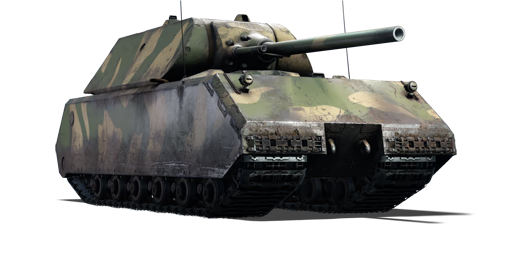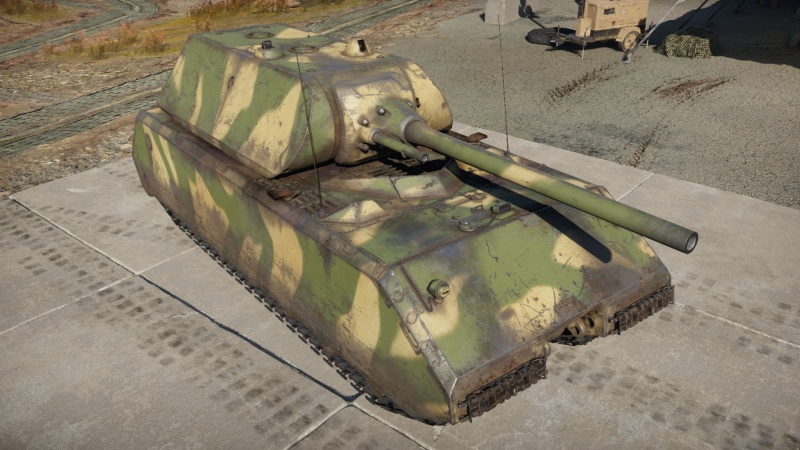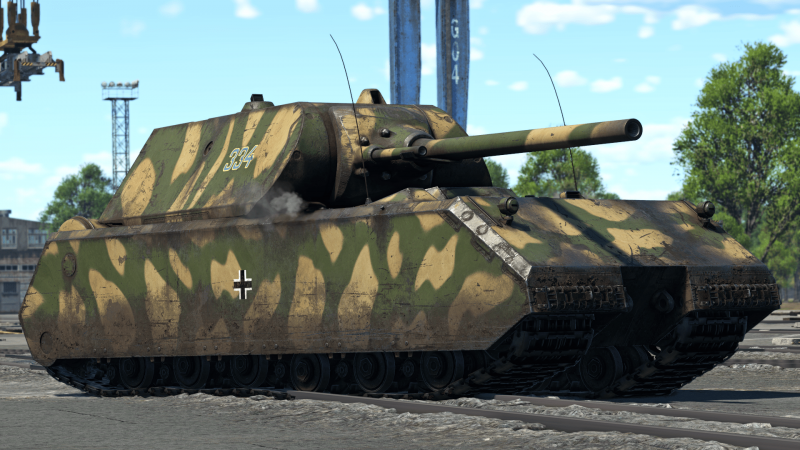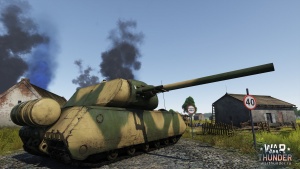Maus
Contents
Description
The Pz.Kpfw. VIII Maus is a rank V German heavy tank with a battle rating of 8.0 (AB) and 7.7 (RB/SB). It was introduced in Update 1.47 "Big Guns" as a main tree vehicle, however in Update 1.91 "Night Vision" it was shifted to become a gift vehicle for players who previously owned it. It was later reopened to research for a limited time during War Thunder's 8th, 9th and 10th anniversary events. The Maus is the definitive tank of heavy armour in Rank V and is one of the largest ground vehicles in-game. The Maus can be a menace in the battlefield and conversely also a bullet magnet, a double-edged sword that must be played correctly or else fall victim to heavy enemy fire.
The Maus lives up to its reputation as a mobile bunker. The dual guns do great damage, however, against high-rank tanks it is best to use the 128 mm main gun. It is important to protect the back armour on the Maus and to make sure it does not get outflanked. Preferable used at long range and choke points. Best used as an armoured beast able to destroy vehicles and take any shot.
Speed on the vehicle is roughly 20 km/h. The sheer mass of the vehicle and its speed makes the mobility difference from the road to off-road negligible. The vehicle can actually turn pretty fast once at Gear 6, which is better than the Jagdtiger and some other Rank V heavy counterparts. Keep that in mind and use it as an advantage in CQC.
The 128 mm KwK44 is a great gun in-game, very accurate and perfect for mid to long range engagements. The reload is very good too for its calibre (23 seconds stock) that is a big advantage against IS-4s, because the Maus has three seconds for an extra shot. It has one of the best penetration value of any APCBC shell in-game alongside the IS-7 and the Object 279. However, the APCR and HEAT shells of the T-54 and late US vehicles surpass it. Damage-wise the 128 mm PzGr.43 is equivalent to the shell BR-471 of the 122 mm D-25T cannon, for which penetration usually means a knock-out.
Coaxial MG? That's for normal tanks (but it is there anyway). On the Maus, everything is bigger. The short 75 mounted alongside the main 128 originally served as anti-infantry and soft target weapon of choice. In War Thunder, these vehicle types are either not found on the battlefield or as latter only on certain maps. It comes without question that the 75 mm should be used against AAA, trucks and SPAA. However, the HEAT shell can be used to harass the enemy, lure them out/in of cover, or just damage medium tank's sides (T-54 and M46 do not exceed 80 mm of armour) tracks and even destroy some lightly-armoured vehicles with overpresssure such as the BMP 1. In addition, the secondary cannon has a good reload rate of around 5 sec, thus it can be used to defeat light tanks and SPAA without wasting the precious 128 mm ammo for more heavily armoured targets.
General info
Survivability and armour
{{Specs-Tank-Armouri loiek men Armour type:
- Rolled homogeneous armour
- Cast homogeneous armour (Gun mantlet)
| Armour | Front | Sides | Rear | Roof |
|---|---|---|---|---|
| Hull | 200 mm (55°) Front glacis 200 mm (35°) Lower glacis |
180 mm Top 100 mm Bottom 300 mm Weld joints |
150 mm (36°) Top 150 mm (31°) Bottom |
50 mm General area 100 mm Front roof |
| Turret | 232 mm (3-53°)Turret front 240 mm Gun mantlet |
205 mm (30°) | 200 mm (15°) | 60 mm |
Notes:
- Armour on the Maus is quite complex, and definitely does not end with the above-mentioned values
- Gun mantlet is 240 mm thick and nicely rounded, right around both guns the armour is 300 mm thick
- Tracks at the front are protected by 100+60 mm plates (100 mm basic plate + attached tracks)
- Behind the frontal upper plate on deck armour, there are many 60 mm highly sloped plates of armour, protecting the engine vents and turret ring from HEAT/HE shells and some small-calibre fire
- Frontal part of the belly is also 100 mm thick (Would be probably good against mines/other explosives), the rest is 50 mm
- Deck armour in front of these plates is also strengthened to an impressive 100 mm
- Side armour is split to two parts, top with 180 mm and bottom with 100 mm + tracks
- Even inside the tank there is armour - there are many 20 mm plates inside the tank, separating crew compartments from various modules, and partially protecting the interior from shrapnel that penetrated the tank from other areas
- One plate is at the rear of the tank, between the enormous transmission and the fighting compartment
- Second one is more to the front, separating fighting compartment from the middle-mounted Engine and its radiators
- Third is in the front between the driver's compartment and the engine
- Around the driver there are many more 20 mm plates, adding some protection to Fuel Tanks located there
Mobility
| Game Mode | Max Speed (km/h) | Weight (tons) | Engine power (horsepower) | Power-to-weight ratio (hp/ton) | |||
|---|---|---|---|---|---|---|---|
| Forward | Reverse | Stock | Upgraded | Stock | Upgraded | ||
| Arcade | 22 | 22 | 188 | 1,549 | 2,290 | 8.24 | 12.18 |
| Realistic | 21 | 21 | 1,061 | 1,200 | 5.64 | 6.38 | |
Modifications and economy
Armaments
Main armament
| 128 mm KwK44 | Turret rotation speed (°/s) | Reloading rate (seconds) | |||||||||||
|---|---|---|---|---|---|---|---|---|---|---|---|---|---|
| Mode | Capacity | Vertical | Horizontal | Stabilizer | Stock | Upgraded | Full | Expert | Aced | Stock | Full | Expert | Aced |
| Arcade | 68 | -7°/+23° | ±180° | N/A | 6.6 | 9.0 | 10.9 | 12.0 | 12.8 | 23.66 | 20.93 | 19.30 | 18.20 |
| Realistic | 4.8 | 5.6 | 6.8 | 7.5 | 8.0 | ||||||||
Ammunition
| Penetration statistics | |||||||
|---|---|---|---|---|---|---|---|
| Ammunition | Type of warhead |
Penetration @ 0° Angle of Attack (mm) | |||||
| 10 m | 100 m | 500 m | 1,000 m | 1,500 m | 2,000 m | ||
| PzGr | APC | 252 | 249 | 237 | 222 | 208 | 196 |
| Sprgr. L/5 | HE | 37 | 37 | 37 | 37 | 37 | 37 |
| PzGr 43 | APCBC | 272 | 269 | 257 | 242 | 228 | 215 |
| 12,8/8,8 Pzgr.TS | APCBC | 312 | 307 | 288 | 266 | 245 | 226 |
| Shell details | |||||||||
|---|---|---|---|---|---|---|---|---|---|
| Ammunition | Type of warhead |
Velocity (m/s) |
Projectile Mass (kg) |
Fuse delay (m) |
Fuse sensitivity (mm) |
Explosive Mass (TNT equivalent) (g) |
Ricochet | ||
| 0% | 50% | 100% | |||||||
| PzGr | APC | 930 | 26.35 | 1.2 | 19 | 786.5 | 48° | 63° | 71° |
| Sprgr. L/5 | HE | 750 | 28 | 0.1 | 0.5 | 3,700 | 79° | 80° | 81° |
| PzGr 43 | APCBC | 940 | 28.3 | 1.2 | 19 | 786.5 | 48° | 63° | 71° |
| 12,8/8,8 Pzgr.TS | APCBC | 1,230 | 9.85 | 1.2 | 19 | 108.8 | 48° | 63° | 71° |
Ammo racks
| Full ammo |
Ammo parts |
1st rack empty |
2nd rack empty |
3rd rack empty |
4th rack empty |
5th rack empty |
6th rack empty |
7th rack empty |
8th rack empty |
9th rack empty |
10th rack empty |
Visual discrepancy |
|---|---|---|---|---|---|---|---|---|---|---|---|---|
| 68 | Projectiles Propellants |
62 (+6) 62 (+6) |
55 (+13) 55 (+13) |
50 (+18) 50 (+18) |
45 (+23) 45 (+23) |
39 (+29) 39 (+29) |
33 (+35) 33 (+35) |
25 (+43) 25 (+43) |
17 (+51) 17 (+51) |
9 (+59) 9 (+59) |
1 (+67) 1 (+67) |
No |
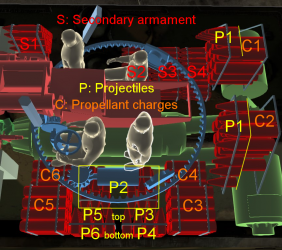
Note:
- Turret empty: 45 (+23) shells.
Additional armament
| 75 mm KwK44 L/36.5 | Reloading rate (seconds) | ||||||
|---|---|---|---|---|---|---|---|
| Capacity | Vertical | Horizontal | Stabilizer | Stock | Full | Expert | Aced |
| 100 | N/A | N/A | N/A | 5.20 | 4.60 | 4.24 | 4.00 |
Ammunition
| Penetration statistics | |||||||
|---|---|---|---|---|---|---|---|
| Ammunition | Type of warhead |
Penetration @ 0° Angle of Attack (mm) | |||||
| 10 m | 100 m | 500 m | 1,000 m | 1,500 m | 2,000 m | ||
| Sprgr. 34 | HE | 10 | 10 | 10 | 10 | 10 | 10 |
| Hl.Gr 38B | HEAT | 80 | 80 | 80 | 80 | 80 | 80 |
| Hl.Gr 38C | HEAT | 100 | 100 | 100 | 100 | 100 | 100 |
| Shell details | |||||||||
|---|---|---|---|---|---|---|---|---|---|
| Ammunition | Type of warhead |
Velocity (m/s) |
Projectile Mass (kg) |
Fuse delay (m) |
Fuse sensitivity (mm) |
Explosive Mass (TNT equivalent) (g) |
Ricochet | ||
| 0% | 50% | 100% | |||||||
| Sprgr. 34 | HE | 420 | 5.74 | 0.1 | 0.1 | 686 | 79° | 80° | 81° |
| Hl.Gr 38B | HEAT | 450 | 4.4 | 0 | 0.1 | 872.1 | 62° | 69° | 73° |
| Hl.Gr 38C | HEAT | 450 | 4.8 | 0 | 0.1 | 875.5 | 62° | 69° | 73° |
| Smoke shell characteristics | ||||||
|---|---|---|---|---|---|---|
| Ammunition | Velocity (m/s) |
Projectile Mass (kg) |
Screen radius (m) |
Screen deploy time (s) |
Screen hold time (s) |
Explosive Mass (TNT equivalent) (g) |
| K.Gr.Rot Nb. | 423 | 6.2 | 13 | 5 | 20 | 50 |
Ammo racks

| Full ammo |
1st rack empty |
2nd rack empty |
3rd rack empty |
4th rack empty |
Visual discrepancy |
|---|---|---|---|---|---|
| 100 | 76 (+24) | 51 (+49) | 26 (+74) | 1 (+99) | No |
Note:
- Turret empty: 76 (+24) shells.
Machine guns
| 7.92 mm MG34 | ||||
|---|---|---|---|---|
| Mount | Capacity (Belt) | Fire rate | Vertical | Horizontal |
| Coaxial | 1,000 (150) | 900 | -7°/+23° | N/A |
Usage in battles
Versus heavy tanks, the Maus has all the advantages. While slower it can make up for this in close combat thanks to the good turn rate of both tracks and turret. Just quickly angle the Maus (both turret and hull) and you will turn it nearly invincible (be advised that HEAT shells can still penetrate the angled turret). Try angling the front drive wheel at the enemy tank and turn the turret so that the armour is at ~45 degrees to the enemy fire. The tanks that pose a threat are the M103, the M48, the Chinese T-62, the BMPs, the Object 120, and basically every tank that has HEATFS, ATGM, or APFSDS rounds that can penetrate more than 320 mm of armour. One good strategy is to capture the objective and just defend it. This can be really helpful to the team.
Versus medium tanks, the Panzerkampfwagen VIII can fight in CQC with its decent turret rotation but at the cost of exposing its side armour and getting flanked. Doing so should be kept as one's last resort. Distance is the ally of the Maus, which should be easy to do considering that the top speed is 20 km/h.
While it is very strong frontally because of its excellent armour, the Maus should be played very carefully: it can be very vulnerable if it gets uptiered where enemies have APFSDS rounds and ATGMs that will go clean through your armour. Try to stay out of close quarters as it will be easier for tanks to take out your gun barrel or move to your sides.
Pros and cons
Pros:
- Heavily-armoured tank, practically invincible if angled properly
- Capable of soaking a large amount of damage and very resilient to bombs and rockets
- Only vulnerable to large-calibre HE shells
- Turret sides are as strong as, if not stronger than, the front of the turret
- Access to smoke grenades
- Surprisingly good off-road manoeuvrability
- Makes decently fast turns in high gear movement or in neutral steering
- Very difficult to immobilize, due to extremely thick track skirts
- Powerful 128 mm cannon and rounds
- Secondary 75 mm coaxial cannon is surprisingly effective when using HEAT rounds
Cons:
- Very slow
- Struggles on hilly terrain
- Requires good teamwork to perform adequately
- Slow turret rotation
- The sides of the Maus are littered with ammo racks
- Very loud engine, players will be able to locate the Maus just by the engine sounds
- Vulnerable at all ranges to modern rounds such as HEAT and sabot rounds
- Towing is practically impossible unless it is done by another Maus
- Large bombs will commonly cripple the Maus, or detonate its fuel tanks
- Optics have little zoom capability, making it difficult for hitting long range targets
- Big target for ATGMs
- No modern armour of any kind, relies completely on conventional armour plating
- Secondary 75 mm is hard to aim
History
Development
This monster of a tank started development in 1942 on the suggestion of Ferdinand Porsche to Hitler, which was approved. The first prototype was to be completed by 1943 and the project vehicle was designated the Mammut (Mammoth). The name changed in December 1942 to Mäuschen (Little Mouse), then once more to the Maus (Mouse) in February 1943, which stayed as its designation (and perhaps proving that Germany does have a sense of humour).
The prototype used Ferdinand's "electric transmission" that was previously used on the rejected Tiger(P), the vehicle would be powered by an MB 517 diesel engine. The Maus has a suspension design with 24 wheels on each side, 2 per bogie with two bogies side by side and six bogies lining up from front and back. The armour was perhaps the most defining feature at 220 mm thick at the hull front, the sides and rear were 190 mm thick. The turret was even thicker at 240 mm on the front and 200 mm on the sides and rear. The vehicle was to also have a 128 mm KwK44 main gun with a 75 mm KwK44 gun as a coaxial. The overwhelming design was approximated to weight 100 tons.
The production plan was to have the prototype completed by mid-1943 and for 10 vehicles per month after the prototype delivery. Work would be divided between Krupp and Alkett for the production of the machine. The wooden model of the tank was presented on May 1943 to Hitler. It was then approved for production and 150 of them were to be built. With the final design finished, it was estimated to weight 188 tons now. Though Hitler and his peers saw it with much favour, Heinz Guderian criticised the Maus design because there was a lack of machine guns, thus it was extremely vulnerable to infantry attacks at close-quarters for the same reason as the Ferdinand tank destroyer. The anti-infantry problem was solved with the addition of a coaxial machine gun and a "Nahverteidigungswaffe" dischargers, firing smoke or high-explosive shells in its surrounding area, installed on the turret.
Production and cancellation
Two prototypes of the Maus were made in 1943 and 1944. The first one, called V1 was turretless and assembled by Alkett in December 1943, it was fitted with a mock turret that helped finalise the turret design in 1944. Here they determine the Maus was definitely too heavy for any bridges in existence so the Maus would ford rivers with a snorkel. The second prototype called V2 by Alkett again had the first produced Maus turret attached with the 128 mm gun, coaxial 75 mm gun, and coaxial machine gun. In July 1944, Krupp was producing four more hulls, but these were scrapped and the whole project stopped on August 1944, though tests with the V2 continued. The weight of the tank meant that the power-to-weight ratio was extremely poor, resulting in the Maus' ideal speed of about 8 miles per hour maximum in ideal conditions.
However, the Maus was never fully produced because it was the only tank that ceased production because of a strategic bombing campaign that would ruin its production facilities. Adding to this, by 1944, the Red Army was advancing deeper and deeper into what was previously German-controlled territory. The vision that the Red Army might capture the testing grounds of the Maus prototypes and the prototypes themselves seem to come closer to reality. The Germans were forced to destroy the prototypes to prevent their capture by the Soviets, placing charges onto the V2 prototype (the V1 was only a hull so it wasn't combat-effective). The second prototype had the entire hull damaged as there was ammunition still in the tank when the charges went off, but the turret was mostly intact. The Soviets captured the damaged prototypes and held them until the end of the war. After World War II, the Soviet Commander of Armoured and Mechanized troops ordered for the V1 hull to be attached with the turret from the V2 prototype. They had to use six Sd.Kfz. 9, the largest half-track vehicles produced by Germany, to move the 55-ton turret to the hull. The fixed prototype was sent back to the Soviet Union for testing and arrive on May 4, 1946. Once this is done, the prototype was sent to Kubinka Tank museum in Russia where it lays today on display for the public.
| Archive of the in-game description | |
|---|---|
|
An experimental super-heavy tank built in Germany towards the end of the war. The project was developed by Ferdinand Porsche. The first tank was assembled at the Alkett factory in Berlin on August 1, 1943. The first trial run of the Type 205/1 tank was conducted on December 24, 1943. The turret still wasn't ready, so a load equal to the weight of the turret was placed on top of the tank. The prototype turned out to be quite manoeuvrable once it was able to leave the assembly area, where it had been rather cramped. According to those who had the opportunity to drive the tank, the Maus was easier to drive than the Pz.Kpfw. IV. In November, 1943 a 44 calibre, 128 mm KwK44 cannon was built that was intended for the tank. The cannon's designation was later changed to 12.8 cm KwK82. The weapon was tested at the Meppen training ground. The turret was installed on the 205/1 prototype on July 6, 1944, and on October 3, 1944 the armament was installed and the fully-outfitted tank was tested at the training ground in Kummersdorf. Both prototypes were tested in Kummersdorf, but no reliable information on these tests is available. Whether or not experimental firing was conducted is also unknown. Toward the end of the war, bodies and turrets had begun to be produced in addition to the prototypes that had been built. As the Soviet troops were approaching in 1945 both prototypes were blown up. Soviet specialists were able to reconstruct one Maus from the wreckage. This rebuilt tank was delivered to the training ground in Kubinka in 1946, where various tests were performed. The Panzerkampfwagen Maus can currently be viewed on display at the tank museum in Kubinka. | |
Media
- Skins
- Images
- Videos
Gameplay/History:
Review:
See also
Links to the articles on the War Thunder Wiki that you think will be useful for the reader, for example:
- reference to the series of the vehicles;
- links to approximate analogues of other nations and research trees.
External links
- [Devblog] Panzerkampfwagen VIII «Maus»
- [Historical] Panzerkampfwagen VIII "Maus", Part I, Part II, and Part III
| Germany heavy tanks | |
|---|---|
| Tiger 1 (Henschel) | Tiger H1 · Tiger E · ␠Tiger |
| Tiger 1 (Porsche) | VK 45.01 (P) · Pz.Bef.Wg.VI P |
| Tiger 2 | Tiger II (P) · Tiger II (H) · Tiger II (H) Sla.16 · Tiger II (10.5 cm Kw.K) |
| Super heavy tanks | Maus · E-100 |
| Trophies | |
| Great Britain | ▀Pz.Kpfw. Churchill |
| USSR | ▀KV-IB · ▀KW I C 756 (r) · ▀KW II 754 (r) |


